Resources
Fresh perspectives on reducing work friction and improving employee experiences. Research, case studies, and insights on how FOUNT helps transform workflows.
.webp)
.webp)

The Pattern That Separates AI Winners from AI Wishful Thinkers in HR
When we analyzed how 25 leading organizations—including BASF, Deutsche Bahn, Novartis, thyssenkrupp—actually implement AI in HR, a clear pattern emerged: It wasn't about the technology. It wasn't about the budget. It was about execution.
The difference between organizations shipping measurable value and those stuck presenting endless slides comes down to a single, replicable value creation pattern.
The Research Foundation: What Data Revealed
Our comprehensive study, validated by 151 HR and AI professionals across leading organizations, uncovered something remarkable. While most HR teams focus on identifying AI opportunities, the successful ones focus on something entirely different: translating insights into shipped products that people actually use.
The data tells a compelling story. Companies achieve:
- 50% productivity gains in HR Operations roles, first impact within 90 days
- 32% faster time-to-hire (from 38 to 26 days) by treating talent acquisition as a product
- 96% user adoption of AI-powered tools in just three weeks
- €1.4M annual cost savings potential per HR Operations Specialist role alone (30,000 employees company)
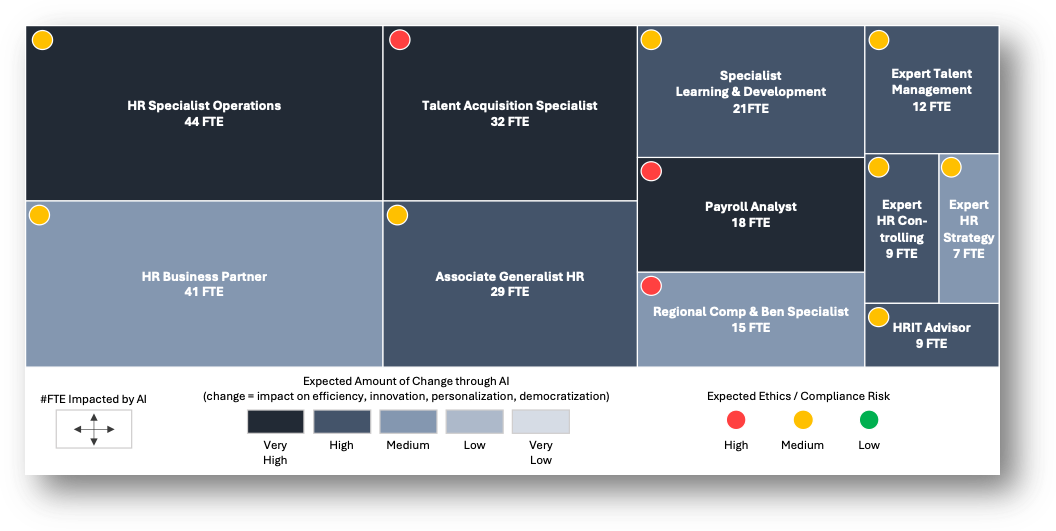
But here's what surprised us most: The technology wasn't the differentiator. The value creation model was.
Beyond Efficiency: The New HR Value Creation Model
The winning HR organizations discovered that AI creates value in ways traditional ROI calculations miss entirely. Yes, there are impressive efficiency gains—our research shows AI can free up 32% capacity in analytics roles and 50% in operations roles. But the real transformation happens when that freed capacity enables entirely new services.
Let’s take the example of a global engineering firm that didn't just automate tasks—they redesigned their entire talent acquisition experience. By treating hiring managers and candidates as customers, not administrative burdens, they reduced time-to-hire by a third while dramatically improving the candidate experience. The secret? They applied product management principles, not just process optimization. And they used AI as automator, augmenter, and assistant.
Extrapolating the talent acquisition example, the company envisions an AI-enabled, product-oriented HR model that looks like this (anonymized):
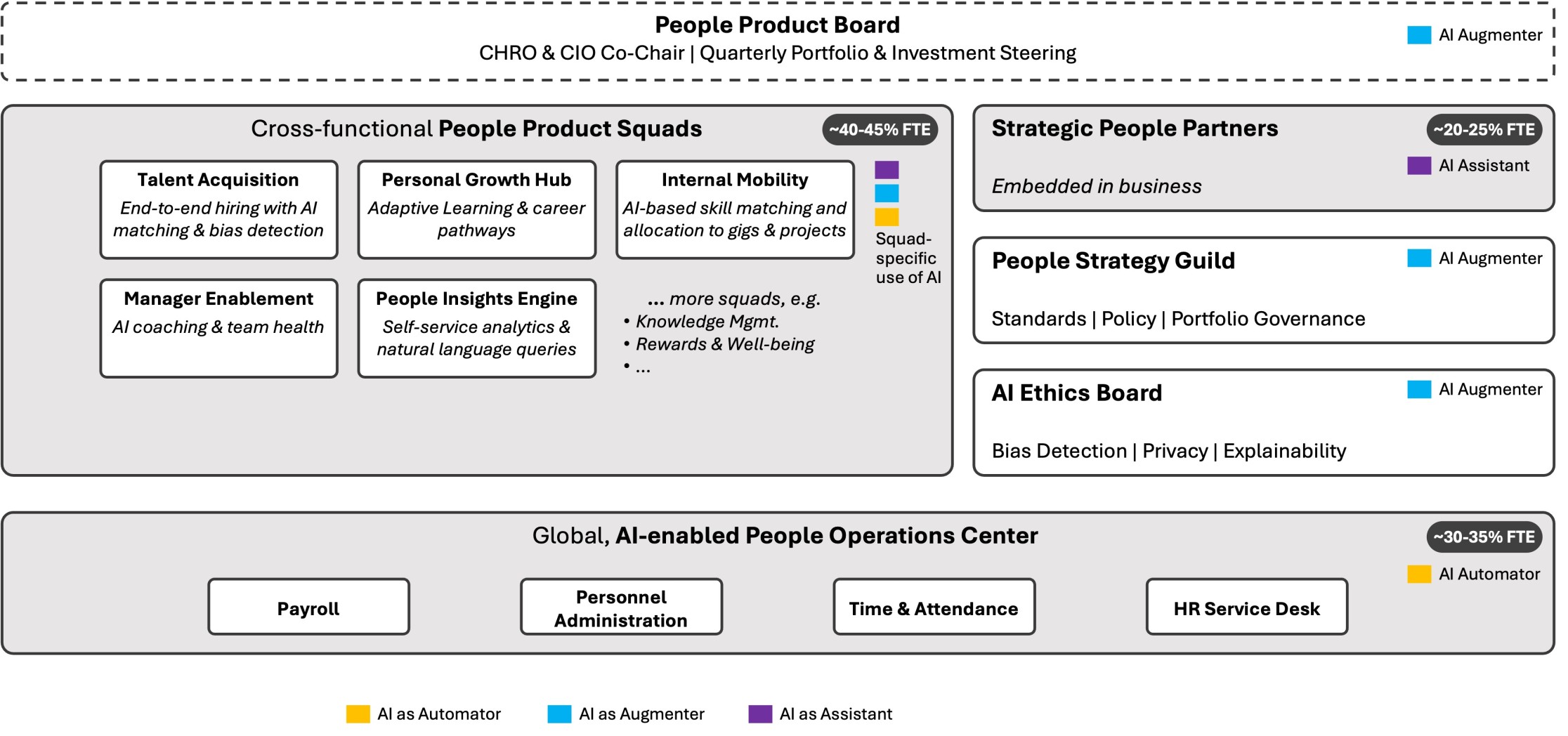
The Value Creation System That Actually Works
After studying successful and stalled implementations of versions of such an AI-powered HR model, we identified the four-module system that consistently delivers results:

- Module 1: Research - Moving beyond pain points to understand actual user needs. One company discovered their "time-consuming administrative work" wasn't about automation—it was about fragmented systems creating unnecessary handoffs.
- Module 2: Product Management - Treating HR services as products with clear value propositions, user-focused metrics, and two-week iteration cycles. This isn't HR speak—its proven methodology borrowed from technology companies that scale successfully.
- Module 3: Hackathon Sprint - Instead of 18 months of committee meetings, successful organizations compress decision-making into 48 hours. A manufacturing company in Germany used this approach to design, test, and approve an enterprise-wide chatbot, including compliance clearance and ROI validation. The result? A ‘go’-decision scaling the solution to cover all topics, all populations by 2027, with break-even projected within 12 months.
- Module 4: Change & Scale - Coaching 1-2 model teams to full adoption while meticulously tracking usage, cycle times, and user sentiment. The key insight: adoption is everything. Without it, even the most sophisticated AI is worthless.
The 48-Hour Decision Engine
The Hackathon Sprint deserves special attention because it solves HR's biggest AI challenge: alignment paralysis. Traditional approaches get bogged down in stakeholder management, compliance reviews, and technical feasibility studies that stretch for months.
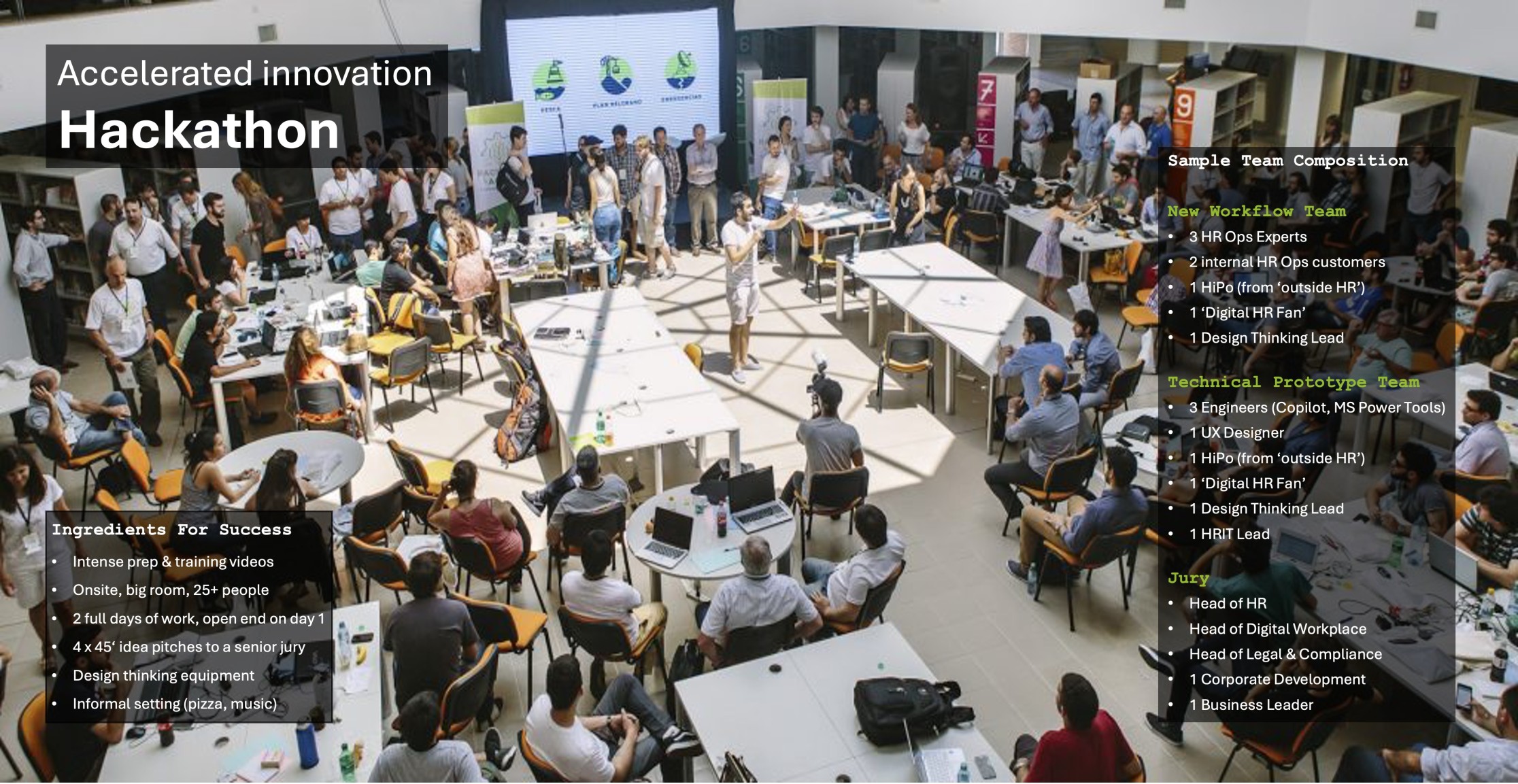
Smart organizations flip this script. They bring HR, IT, legal, security, and business leaders into one room with actual users and working prototypes. In 48 hours, cross-functional teams build, test, validate compliance, estimate ROI, and make go/no-go decisions.
The results speak for themselves: Organizations using this approach report 95% faster time-to-implementation compared to traditional approaches. More importantly, they build momentum that carries forward into full-scale implementation. And very simply put, they learn how to deal with AI.
Success Factors That Keep the System Running
Three enablers separate sustained success from one-time wins:
Start Role-Specific - Don't try to transform everything at once. Begin where AI can move a visible needle—typically HR Operations or Talent Acquisition—then expand systematically.
Obsess Over Adoption - One organization reached 96% hiring manager adoption of their AI scheduler in three weeks. Their secret? They optimized relentlessly for user experience, not technical features.
Measure What Matters - Track adoption rates, and its biggest driver: The removal of work friction for managers and employees. Remember: a perfect AI tool that nobody uses creates zero value.
In 90 Days From Assessment to Action
The pattern is clear, and it's replicable. The question isn't whether AI will transform HR—it's whether your organization will lead or follow.
- If you lack clarity on where to start: Begin with Module 1 (Research) to prioritize by user need and quantified value potential. Our AI Impact Assessment can provide role-specific insights for your organization in just 48 hours.
- If product orientation hasn’t found its way into HR: Module 2 (Product Management) will set up the foundations, with focus on just one, AI-enabled HR product platform, and with a product manager to own it.
- If you have identified opportunities but lack momentum: Run Module 3 (Hackathon Sprint) on your top two use cases. The intensive, cross-functional format breaks through alignment barriers that stall traditional approaches.
- If you have working prototypes but low adoption: Focus on Module 4 (Change & Scale) with clear adoption metrics and user-centered optimization.
The Bottom Line
The organizations winning with AI in HR aren't just automating existing processes—they're fundamentally reimagining how HR creates value. They start small, move fast, and scale what proves valuable to actual users. A very realistic, conservative, staggered business (parameters: 30,000-employee organization, focus on two HR roles, positive ROI in year 1) can look like this:
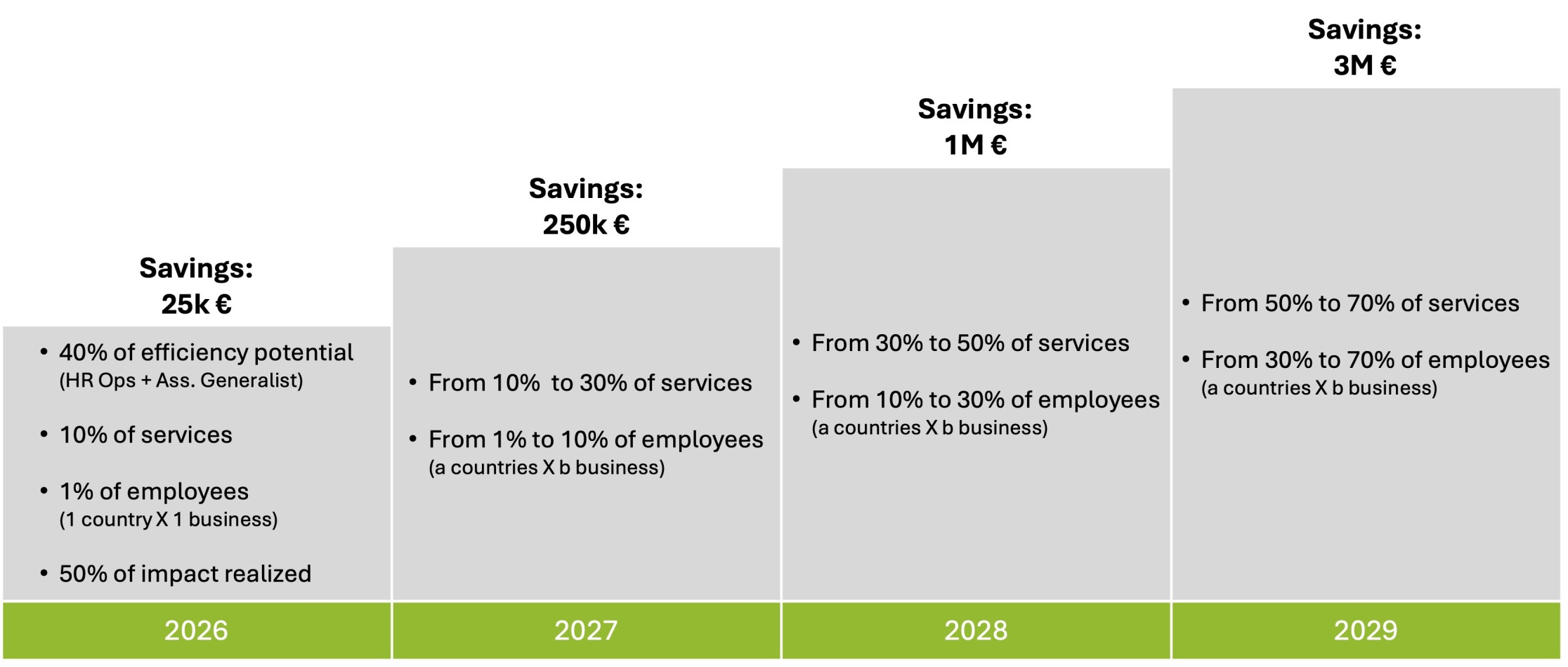
The methodology exists. The case studies are proven. The remaining question is: Which approach will define your organization's AI journey—systematic, staggered execution or hopeful experimentation?
What's your organization's biggest barrier to moving from AI assessment to AI results? I'd be interested in your perspective.

The Impact of Workplace Friction on Knowledge Workers: Examining Burnout and Its Broader Consequences on CX
By Matt LeVeque
Matt LeVeque is a customer and product success executive with 30 years in Employee and Customer Experience, Team Development, and Organizational Change. As founder of Mind the Canary, he applies expertise in Motivational Work Design, Lean Six Sigma, and Organizational Change Management to drive employee engagement and customer satisfaction. Previously, as Director of Product Management for Employee Experience at Comcast, he introduced motivational work design and behavioral product management, pioneering an AI-backed eNPS analysis tool.
Introduction
Workplace friction occurs when inefficiencies, miscommunication, or conflict disrupts the flow of work and has become a substantial challenge for knowledge workers. This article explores how such friction contributes to occupational burnout, assessing its quantitative toll on productivity and qualitative impact on employee well-being and job satisfaction. It also examines how friction and burnout affect customer experience, proposing strategies grounded in Greg R. Oldham and J. Richard Hackman’s Job Characteristics Model (JCM) and Dr Christina Maslach’s Areas of Work-Life Assessment Survey (AWS) to cultivate a healthier, more effective work environment.
To truly grasp the significance of workplace friction, we must examine its connection to burnout and explore the far-reaching consequences it holds for both individuals and organizations. Beyond the immediate frustration and productivity loss, workplace friction sets the stage for a cascade of negative effects that ultimately impact employee well-being, job satisfaction, and even customer experience. Let’s examine this intricate relationship more closely, drawing upon established models like the Job Characteristics Model and the Areas of Work-Life Assessment Survey to understand the dynamics at play and identify potential solutions.
Understanding Workplace Friction & Burnout in Knowledge Work
The pathway from friction to burnout is well-documented, particularly through conditions outlined in Maslach’s Areas of Work-Life model. When knowledge workers face high demands, low control, and limited support, they experience “micro-stresses” that gradually erode enthusiasm and foster disengagement. The cumulative effects include cognitive overload, as non-value-added tasks create stress and strain. Reduced autonomy and engagement follow, with friction impeding autonomy and intrinsic motivation. Lastly, friction-induced delays and slow progress erode a sense of purpose, fostering feelings of cynicism and detachment. Addressing these friction points is crucial to preserving the motivation and well-being of knowledge workers.
The Cost of Workplace Friction
Lost Productivity: According to the American Psychological Association, workplace stress, often aggravated by friction, costs U.S. employers up to $300 billion annually in lost productivity. Gallup’s research further shows that disengaged employees, frequently the result of workplace friction, cost U.S. companies between $450 billion and $550 billion annually.
Occupational Burnout: The World Health Organization (WHO) defines burnout as an ‘occupational phenomenon’ emerging from chronic, unmanaged workplace stress. Studies by Maslach and Leiter highlight a strong link between friction and burnout, noting that individuals experiencing high friction levels are more prone to burnout symptoms such as exhaustion, cynicism, and reduced efficacy.
The Ripple Effect from Employee to Customer: Workplace friction and burnout have a direct, measurable impact on both employee experience and customer experience. Poor EX, characterized by low engagement, high stress, and high burnout, often leads to diminished job performance and productivity. When employees are disengaged or stressed, they are more likely to make errors, have negative interactions with customers, and struggle with responsiveness.
A study by Qualtrics found that companies with highly engaged employees had a 10% increase in customer ratings and a 20% boost in sales compared to organizations with low employee engagement. Consequently, improving EX by reducing friction and burnout is essential for maintaining a positive CX.
Charting a Path for Utility Digital Transformation Breaking silos between employee experience and customer experience can lead to a massive opportunity for revenue growth of up to 50% or more.
Strategies for Mitigating Workplace Friction and Burnout
Navigating the complexities of workplace friction and burnout requires a strategic and data-driven approach.
Before implementing any interventions, it’s crucial to gain a clear understanding of where friction points exist, and which areas offer the greatest potential for improvement. This targeted approach ensures that resources are allocated effectively and that solutions are tailored to address the specific needs of knowledge workers.
Fortunately, insights from Greg R. Oldham and J. Richard Hackman’s Job Characteristics Model (JCM) and Dr. Christina Maslach’s Areas of Work-Life Assessment (AWS) provide a strong foundation for identifying specific areas that impact motivation, satisfaction, and well-being.
Job Characteristics Model (JCM): The JCM suggests that job design can strongly influence motivation and satisfaction. By focusing on the following aspects, organizations can make work more engaging and fulfilling:
- Skill Variety: Offering diverse tasks and the opportunity to use multiple skills.
- Task Identity: Enabling employees to complete tasks from start to finish, fostering ownership and accomplishment.
- Task Significance: Helping employees see the broader impact and purpose of their work.
- Autonomy: Giving employees control over their work processes and decisions.
- Feedback: Providing constructive feedback to support learning and growth.
Areas of Work-Life Assessment (AWS): AWS provides a framework for evaluating and addressing work-related stress by focusing on six critical areas:
- Workload: Balancing workloads to avoid burnout and underutilization.
- Control: Empowering employees with autonomy in decision-making.
- Reward: Ensuring fair compensation and recognition.
- Community: Building a supportive, connected work environment.
- Fairness: Promoting just treatment and ethical practices.
- Values: Aligning work with employees’ personal values and beliefs.
To effectively implement these frameworks and foster a healthier, more resilient workforce, it’s essential for organizations to adopt a holistic and proactive data-driven mindset. This means continuously monitoring and adapting the work environment to align with employees’ evolving needs and the changing nature of work itself. Regular, scalable feedback loops on daily activities and interactions with tools are crucial for sustaining positive changes over time. That’s where software like FOUNT is uniquely positioned to provide this type of insight.
Let’s take a look!
FOUNT’s Approach: Scalable Software Solution to Identify and Quantify Workplace Friction
As we’ve discussed, the Job Characteristic Model (JCM) and Maslach’s Areas of Work-life Assessment Survey (AWS) are time-tested and proven frameworks to make jobs frictionless and void of occupational burnout. However, both JCM and AWS are manual in nature and, together, only shape part of the story. What is needed in today’s workplace to truly support knowledge workers is near-real time, in the moment feedback on processes. And that is where FOUNT shines.
FOUNT, a survey-based SaaS platform, specializes in uncovering and quantifying workplace friction, providing leaders with actionable insights to enhance productivity and well-being. Through targeted employee feedback on key daily work activities, FOUNT’s platform identifies critical friction points and translates them into clear, data-driven solutions.
Key features include:
- Friction Diagnostics: FOUNT’s friction audits systematically identify workflow obstacles, mapping out areas with the highest impact on employee productivity across functions.
- Dynamic Analytics: FOUNT’s real-time data and analytics correlate friction patterns with productivity metrics and employee satisfaction, offering a timely understanding of emerging issues.
- Strategic Actionable Recommendations: The platform provides tailored, insight-driven recommendations, enabling leaders to make targeted improvements that align with specific organizational goals and streamline work processes.
FOUNT is more than just a platform; it’s a comprehensive solution for organizations seeking to eliminate workplace friction. By identifying productivity bottlenecks, analyzing their impact on performance and morale, and providing tailored recommendations, FOUNT empowers leaders with the data-driven insights they need to optimize workflows and boost employee satisfaction. Ultimately, FOUNT helps organizations achieve greater success by fostering a smoother, more efficient, and more fulfilling work experience.
Now, with FOUNT, leaders who proactively improve workflows, support autonomy, and strategically invest in efficient tools not only benefit employee well-being but also strengthen the organization’s resilience, innovative capacity, and customer experience.
Reduced Friction + Reduced Burnout → Healthy Employees + Increased Customer Satisfaction
Workplace friction is more than a mere inconvenience; it is a pressing issue that can profoundly affect employee well-being, and customer satisfaction. For knowledge workers, who rely on a collaborative, autonomous, and frictionless environment to innovate and solve complex problems, the impact of friction is particularly severe. By addressing key areas such as job design, workload balance, and organizational support – guided by models like the Job Characteristics Model and Maslach’s Areas of Work-Life Assessment – organizations can mitigate burnout and foster a healthier work environment. FOUNT further enables leaders to proactively identify and alleviate friction, enhancing both employee experience and organizational resilience.
While understanding the causes and consequences of workplace friction is crucial, it’s equally important to translate that knowledge into action. This is where a proactive, data-driven approach becomes essential. By leveraging FOUNT, organizations can gain a deeper understanding of the specific friction points impacting their workforce and develop targeted strategies to address them. This shift towards proactive intervention not only mitigates burnout but also unlocks a wealth of benefits that extend far beyond individual well-being.
Ultimately, reducing workplace friction is not only essential for preventing burnout but is also a strategic investment in long-term success, benefiting employees, customers, and the organization as a whole.
Subscribe to Matt’s Bi-Weekly Newsletter: Motivation at Work
.png)
August Newsletter: AI + HR = Transformation (And Friction). HR Edition.
More and more these days, AI is the undisputed future of HR.
Just as it has in other critical business areas, however, AI has brought to HR not only the promise of increased productivity and efficiency, but a fair amount of disruption as well. That’s to be expected with transformative technology. But what does it mean going forward?
For HR leaders, the goal should be to deliver more value for internal customers at lower cost while leveraging the full potential of AI. And that means reducing friction in three key areas:
- HR's internal Customers Workflows
- Employees Workflows
- People Leaders and Business Leaders Workflows
Use AI to remove the barriers that keep people from doing their work efficiently and effectively, and you’ll unlock new value and opportunity. But you can’t reduce friction if you can’t see it. That’s why reliable friction data is such a key piece of the AI puzzle for HR leaders.
The bottom line: AI’s impact on HR can be immense. For example, research from FOUNT Global, Inc. partner TI People found the potential for 29% average efficiency across all HR roles using AI. For some organizations, it could be much higher.

If you’d like to learn how to thoroughly examine the impact of AI on your HR role in just 48 hours, TI People’s AI Impact Assessment can help.
Number of the Month: Confronting Tech Friction
Thinking about AI? Then you’d better be thinking about friction, too.
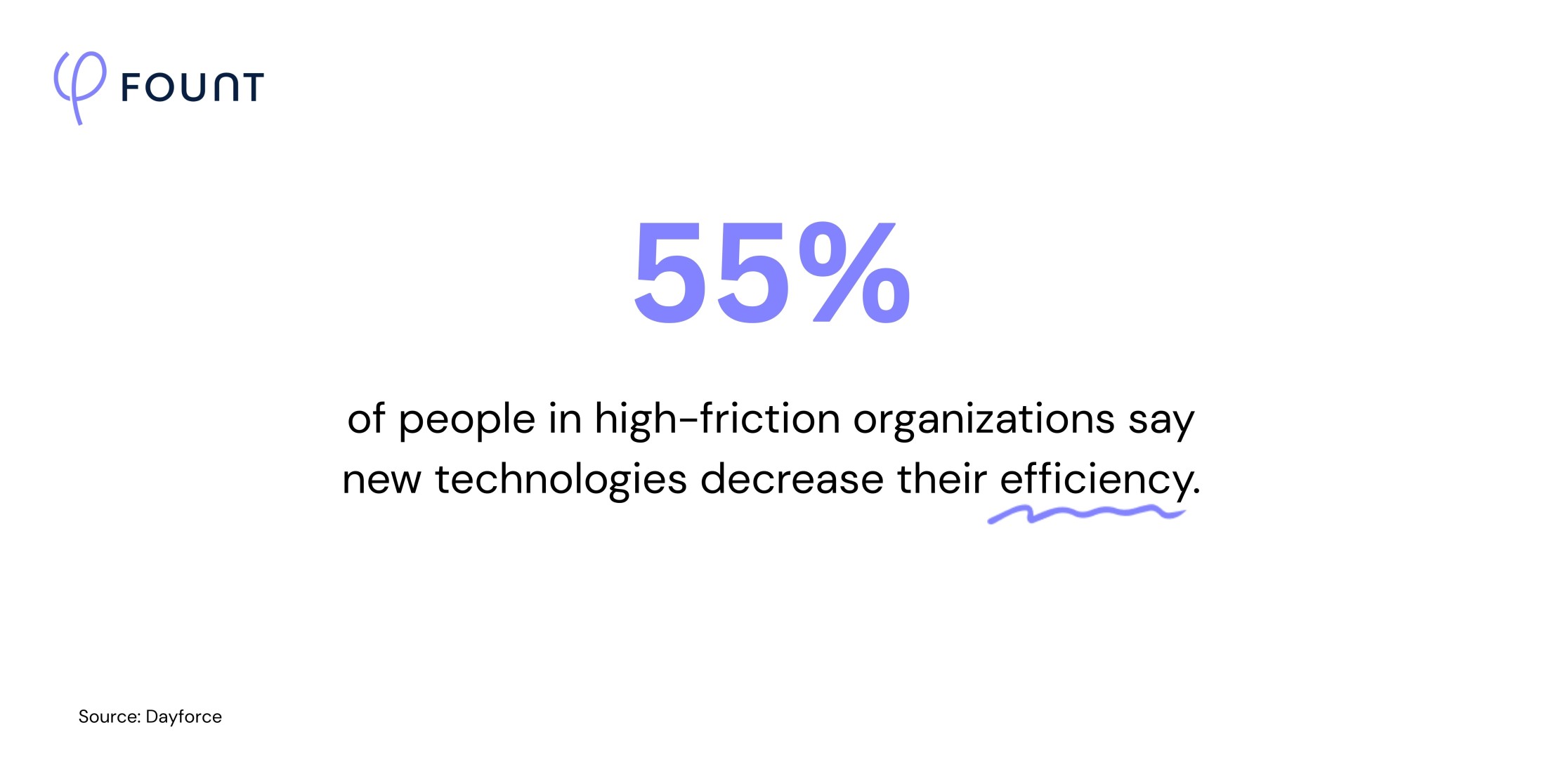
Article of the month:
Reducing friction and giving time back to people leaders ($$$)
Stephanie Denino is bringing numbers to a question HR and People Experience leaders often wrestle with: How do you prove the business value of a better employee experience?
She shows that even modest friction improvements can translate into staggering returns. In one modeled enterprise, simply cutting wasted time in people leader workflows by 15% freed up nearly $16 million worth of hours for leaders to spend on higher-value activities. That’s the kind of data-backed story every HR leader can take to their CFO - clear evidence that fighting friction isn’t just about employee satisfaction, it’s about unlocking measurable business value.

What we are reading:
📖Beyond the Buzz: Why a “Careful Pace” on AI Adoption Can Scale HR’s Impact
Most conversations about AI tend to focus on job disruption and operational efficiency. But HR’s role in this rollout should be both more expansive and more careful – namely, to champion AI’s potential to transform business and workforce outcomes positively and sustainably.
📖 Employees Are Avoiding AI – HR Can Help Them Embrace It
Looking to boost AI enthusiasm in your organization? HR can help by providing not only education, but also clarity and transparency around how the technology fits into the company’s strategy.
📖Report: Most AI Business Investments Fail
New research from MIT shows that 95% of enterprise AI investments aren't ROI-positive. One bright spot? Back-office projects (like HR), which tend to be among the best-performing use cases.
📖 Which Missing Skills are Holding Back AI Adoption?
Deficits in areas such as cognitive skills, AI responsibility, self-management skills, and communication may be hindering the adoption of AI tools in the workplace according to researchers.
Until next time,
The FOUNT Team
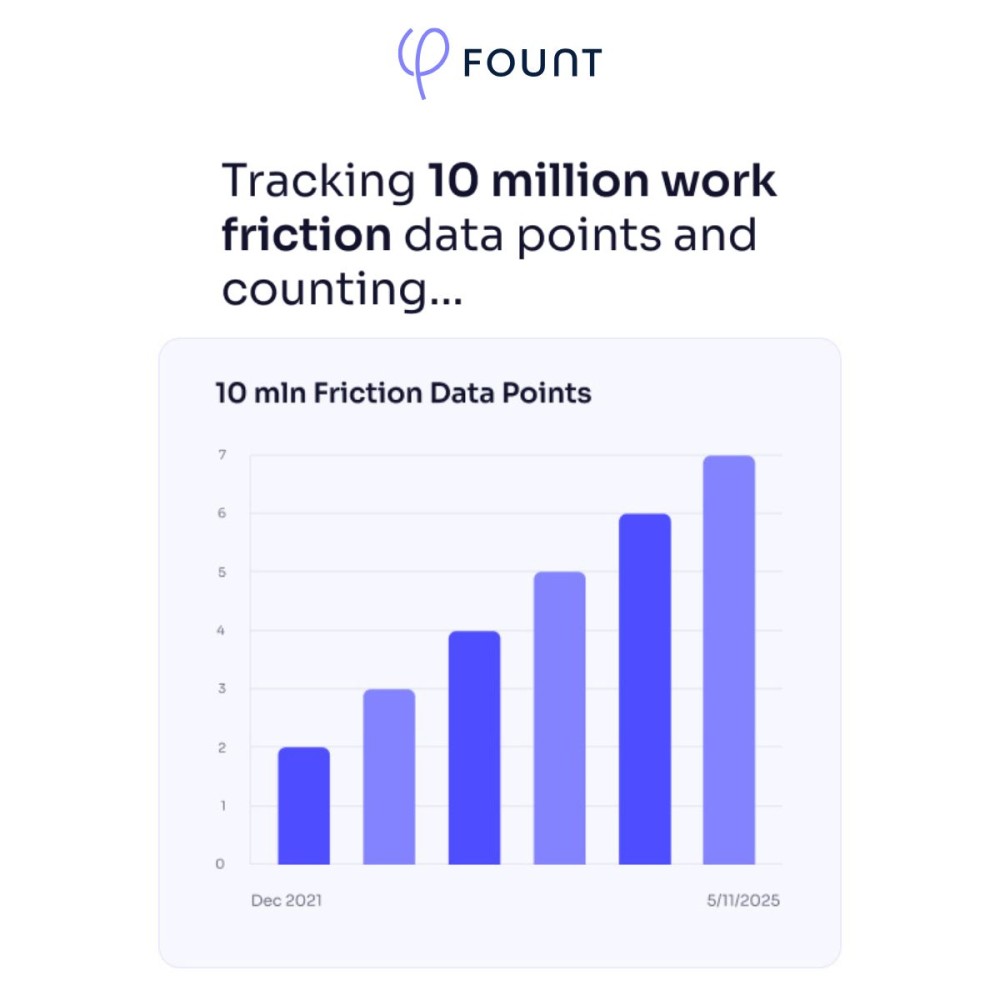

AI is Reshaping the HR Operating Model: Here’s What 15 Leading Companies Discovered
Written by Volker Jacobs, CEO and Founder of TI People, board member at FOUNT Global

This research was co-created with 151 human experts from 15 major companies who provided more than 2,500 data points to validate and train multiple large language models. Industry experts including Andrew Spence , Jonathan Ferrar , Jörg Stegert , Stefan Hoffmann and others contributed to validating the findings.
The Traditional HR Model is Being Squeezed from Both Directions
The HR function stands at a pivotal moment. After decades of following the three-pillar model (Centers of Excellence, Business Partners, and Shared Services), the HR operating model is being fundamentally disrupted by AI from two directions simultaneously:
From the top: Business leaders increasingly demand integrated solutions to complex people challenges rather than siloed HR expertise.
From the bottom: AI is rapidly automating transactional tasks while extending into domains previously considered territory for experts.
Our groundbreaking research, co-created with 15 major European enterprises including BASF, Deutsche Bahn, Novartis, thyssenkrupp, Symrise AG, Brose Group, GXO Logistics, Inc. and validated by industry experts including David Green 🇺🇦, John Boudreau, Thomas Otter, and others reveals exactly how AI is transforming HR roles and activities.
The Numbers That Matter
For a 30,000-employee company, our research shows:
- 29% average efficiency potential across HR functions
- €5.2M in annual cost savings potential that can be reinvested
- HR Specialist Operations roles face 50% efficiency impact (highest among all roles)
- HR Business Partners see 19% efficiency potential while being pushed to deliver more strategic value
The data reveals that AI isn’t just automating HR—it’s transforming how value is created across three dimensions:
- Efficiency: Automating routine tasks to free up HR capacity
- Innovation: Enabling entirely new HR services that were previously impossible
- Personalization & Democratization: Extending high-quality HR services to broader employee populations in a more personalized way
“Really fascinating work – and based on the work, it’s made me realize that the impact on HR may be higher than I’d previously thought.” @David Green, Co-Author of Excellence in People Analytics
The research leading up to these and many more detailed insights can be easily infused in any large organization. It has been compiled into an ‘AI Impact Assessment’ tool, providing comprehensive, company-specific insights in just two days.
The New HR Operating Model

Our research validates a shift toward product-oriented HR structures, where:
- Product Managers own end-to-end HR products aligned to key user needs
- Problem Solvers work across traditional boundaries to address complex business challenges
- Service Delivery teams orchestrate AI-human collaboration
- AI handles increasing portions of transactional and analytical work
What’s striking is how differently AI impacts various HR roles. While operational roles like HR Operations Specialists (50%) and HR Controlling/Analytics (32%) show the highest efficiency potential, even strategic roles like HR Business Partners (19%) will see meaningful transformation.
Three Critical Steps for CHROs
Based on our research with companies like GEA Group, R+V Versicherung, and SEW Eurodrive, here are the essential first steps:
- Assess your starting point: Evaluate your current operating model maturity, AI readiness, technology landscape, workforce capabilities, and value creation potential.
- Define your target HR operating model: Design your product-oriented structure with clear role definitions, governance framework, and value measurement system.
- Build product management capabilities: Most HR functions have limited experience with product management approaches.
Organizations implementing these principles show 40% higher returns on technology investments by redefining HR offerings around user needs rather than functional domains.
The Skills Gap Challenge
The transformation extends beyond technology. Nearly half (47%) of organizations cite insufficient training as their primary barrier to AI adoption. Our research shows HR functions need a balanced approach of 60% reskilling existing staff and 40% strategic hiring across most roles.
The five most critical skills for future HR professionals:
- AI & Machine Learning Literacy
- Human-Centered Design
- Digital Product Management
- Data Science & Analytics
- Ethical AI Governance
What’s Next?
The tipping point for AI in HR has arrived. Generative AI represents the most significant opportunity to reshape HR in decades. ‘Squaring the circle’ and delivering more (business value) for less (HR cost) becomes possible.
For the full research or to discuss how these findings apply to your organization, contact Volker for a personalized readout session.
He’ll share detailed AI impact projections by HR role, skills gap assessments, and practical implementation strategies using product management principles.

July Newsletter: Your Transformation Data Is Only Telling Half the Story. GBS Edition.
It’s easy to think the transformation led by your Shared Services team is on track. SLAs are met, NPS is green, and all your outstanding tickets are closed. Mission accomplished, right?
Not necessarily. What if your supposedly tried-and-true metrics are only telling you part of the story?
As one presenter shared during our recent SSON webinar: “We measure what’s easy to measure, not what’s right to measure. And we realize very soon that we really don’t have a clue what is going on for the employee.”
The rest of the story is in the friction your workers experience - and most companies don’t see it. Why? Because today’s traditional feedback tools (siloed surveys, usage data etc.) are missing the big picture:
- They focus on transactions instead of journeys.
- They measure just sentiment rather than friction.
- They show tool usage, not workflow breakdowns.
It all adds up to a lot of useful, but ultimately deficient, information. And it leads to misdiagnosed problems and wasted investments.
Don’t gamble the success of your transformation initiatives on incomplete insights. Friction data from FOUNT eliminates your blind spots and connects experience in their workflow by quantifying the obstacles that prevent your employees from working productively and efficiently.
It’s the missing half of the story to get your GBS transformation across the finish line.
Captions are auto generated
Play
Stephanie Denino on seeing the bigger picture. Clip from the SSON Webinar
FOUNT in Action: From Tool Performance to Employee Experience
As part of a digitization initiative to wholly transform its IT, HR, and finance services, a US-based company rolled out a new employee portal and a virtual agent to support across all core employee workflows. However, as employees began using these new features, one thing became clear – the tools were working, but the experience was failing.
Case in point: Vanessa, a longtime accounting admin, was working through the multi-step journey of requesting medical leave using the new tools, as well as old standbys like her manager, the employee contact center, and her doctor’s office. And while the request was ultimately processed and approved, not everything went smoothly – in fact, some of it was downright maddening.
In measuring success by SLA and CSAT, however, the company saw feedback that mostly looked great. The systems were in place, the portals worked, and the tickets were tracked. But this was only a partial picture. While many of the back-end services and processes underlying her journey worked well, others left Vanessa feeling frustrated and confused.

The company partnered with FOUNT to find out which specific aspects of the medical leave request and approval process, such as unclear policies and complex paperwork, were causing employees like Vanessa friction.

Curious how this case was developed? Watch our recent SSON webinar.
This is just one example.
View More Use Cases → How Customers Use FOUNT: Accelerate AI Adoption, Reduce Waste, and Measure ROI Sooner - FOUNT
Number of the Month: The Growing Role of Gen AI in Global Business Services
In 2024, 42% of GBS organizations piloted Gen AI. How are things working out? 63% reported measurable gains in productivity, cost savings, and service quality. – The Hackett Group

The Latest Guest Post:
📖3 Signs Your GBS Is Creating Friction Instead of Flow (And How to Fix It)
By Isabella Kosch, freelance business consultant, ex-Head of GBS Service Management at SWAROVSKI, regular contributor to SSON.
Discover hidden friction points in your GBS operations that quietly undermine employee trust and efficiency. Plus: get actionable advice on how to fix them. Get the full story
What we are Reading:
📖 Understanding AI ≠ Using It
The relationship between AI literacy and receptivity may surprise you. Research shows that people with lower AI literacy are more likely to embrace it, while those with higher AI literacy tend to lose interest quickly. Get the full story
📖 Agile Leadership in GBS: Leading Through Uncertainty and Change
GBS is evolving from a cost-saving function to a strategic enabler. To keep pace, GBS leaders must shift their focus from operational (or basic) efficiency to driving value. Get the full story
📖 Breaking the False Tradeoff in GBS: Efficiency vs. Experience
Ever wonder why modern leaders are measuring friction and using experience data to drive productivity, reduce costs, and transform service quality? Find out here. Get the full story
📖 The Data Race: Global Business Services’ Advantageous Positioning with Gen AI
How can Gen AI help GBS leaders forge a strategic path forward? Start with a shift in focus, from basic processing to enhanced data-driven insights. Get the full story
Come Out and Meet FOUNT:
Engage 2025, organized by Everest Group
Where: Dallas, TX
When: September 8 – 10
Engage — Dallas 2025 - Everest Group

Shared Services & Outsourcing Week Conference, organized by SSON
Where: Houston, TX
When: September 15 – 18
Shared Services & Outsourcing Week 2025

Want to learn how FOUNT can reduce friction in your transformation? Let’s talk.
Until next time,
The FOUNT Team
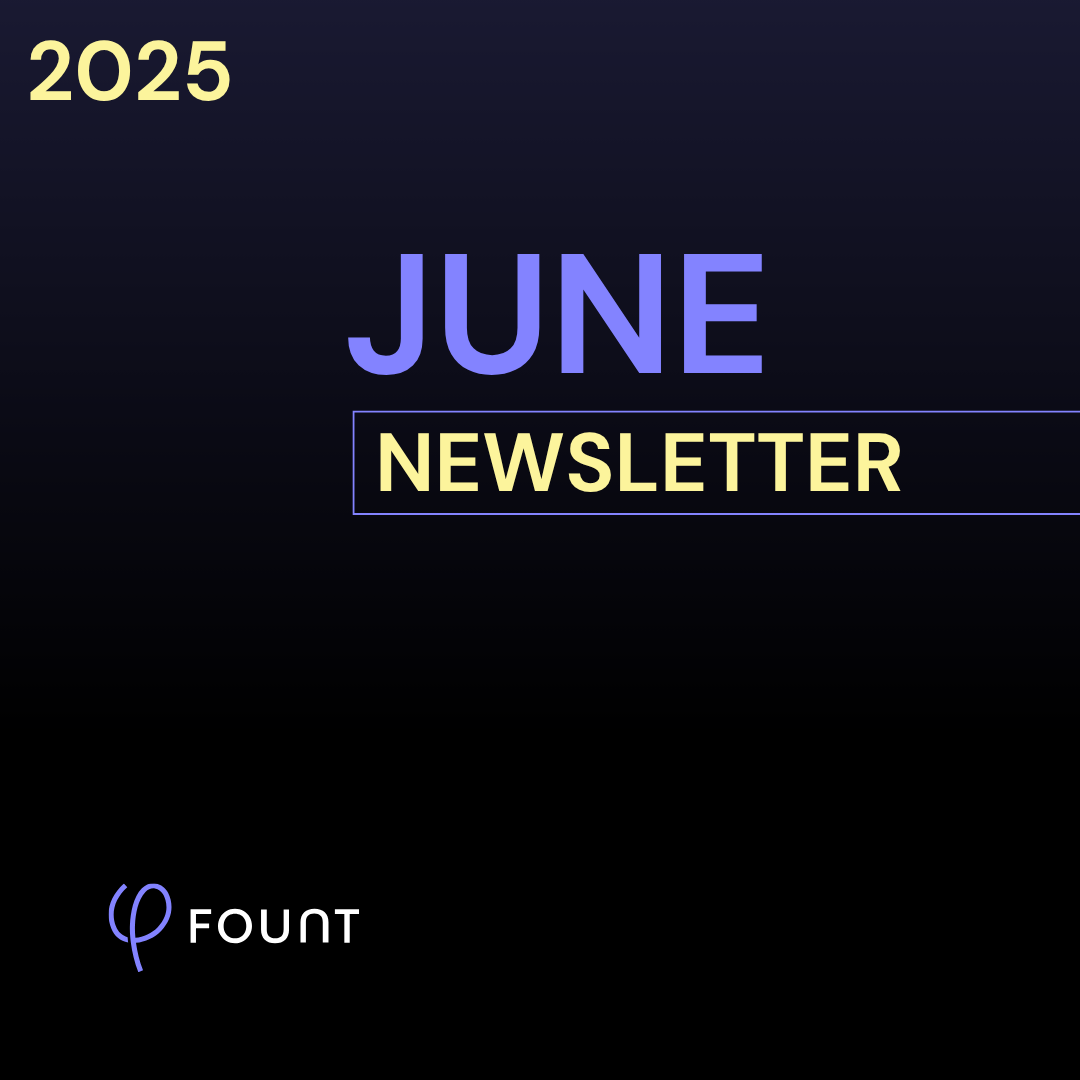
June Newsletter: Friction is Killing Your AI ROI.
Enterprise AI spend is expected to increase 75% in 2026, per new a16z research. At the same time, enterprise leaders are resistant to outcome-based pricing models because of a “lack of clear, measurable outcomes” tied to the tech.
In other words: enterprises are spending more on AI but still don’t know how to make it deliver ROI.
That’s because nearly every AI deployment – and industry analysis, for that matter – ignores the problem of friction.
What is friction? It’s any person, process, or technology that prevents people from doing their work.
And it’s a huge reason why AI projects don’t deliver as promised in the business case. That’s because AI is a bottom-up technology: it depends on individual users implementing an AI tool day after day in task after task.
But if a tool isn’t easy to use, they won’t use it. And there goes your investment.
Friction is more pervasive than most enterprise leaders realize:
- 87% of employees report friction from trapped resources
- 50% report overwhelmed teams as the cause
- 48% are stymied by rigid processes
Bottom line: if you’re investing in AI without also measuring friction, you likely won’t see the ROI promised by the business case. Not sure how to measure friction? Read on.
🎙️ Now live: SSON podcast with Christophe Martel, CEO of FOUNT Global – on why transformation stalls when friction goes unmeasured, and how leaders can change that. 🔗 https://www.ssonetwork.com/intelligent-automation/podcasts/friction-data-blocking-ai-transformation
FOUNT in Action: How to Weed Out Friction in the Enterprise
Use case 1: Gamma Financial drives AI chatbot adoption, slashes $5.4 million per year in friction
Gamma Financial, a large financial services organization, introduced an AI chatbot to help its IT team code more efficiently. A few months after rollout, however, overall productivity for the team hadn’t budged.
The company worked with FOUNT to identify friction sources for the team and discovered that the documentation underpinning the codebase was subpar. This meant the AI chatbot, trained on that dataset, was not as helpful as it could be – which meant the junior developers who could have most benefitted from AI assistance weren’t using the bot.
With a clear sense of the main source of friction, Gamma was able to update documentation, improve chatbot adoption, and ultimately slash $5.4 million per year of wasted IT team hours.
Use case 2: A CPG giant tweaks its AI-powered ordering system to cut product waste
A CPG giant launched an AI-powered ordering system to streamline relationships with vendors. But early on, vendors were frustrated: they started getting too much of some products and too little of others. Product was expiring and they were missing out on potential sales.
Tensions were rising among valued vendor partners, so the company decided to look for friction.
They discovered that the AI system didn’t account for certain demand nuances, like when a product was popular due to temporary circumstances but wouldn’t be in the future. The solution: update the AI system to include more parameters so it could accurately reflect vendors’ needs.
The updated system reduced product waste while also ensuring vendors had what they needed in stores.
Use Case 3: Global enterprise accelerates Agile transformation
A global enterprise was shifting from Waterfall to Agile product development. As part of the change, it introduced a new Product Owner (PO) role and competency framework across five business units. Some POs were hired externally; others transitioned internally – bringing diverse backgrounds and interpretations of the role.
To support the transition and ensure teams could work effectively, the company partnered with FOUNT to identify sources of friction impacting the PO role.
FOUNT’s analysis surfaced two key blockers:
- Leadership Misalignment – Business, Technical, and Product leaders lacked alignment on priorities, complicating decision-making for POs.
- Role Clarity Gaps – Expectations for the PO role varied across units, and POs were often stretched thin or pulled into responsibilities outside their remit.
By addressing these friction points, the company implemented targeted improvements, resulting in a 26% improvement in Feature Time to Release, signaling a smoother transition to Agile and better alignment across teams.
Most Recent Blog Posts:
Breaking the False Tradeoff in GBS: Efficiency vs. Experience
Too many GBS teams are stuck in a false tradeoff: efficiency vs. experience. But modern leaders are measuring friction and using experience data to drive productivity, reduce costs, and transform service quality. This piece explores an emerging framework for GBS leaders.
🤔Dig into this emerging line of thinking

What We Are Reading:
Recalculating the Costs and Benefits of Gen AI
In this HBR article, associate professor of organizational behavior Mark Mortensen suggests considering not just the potential benefits of generative AI (increased speed and productivity, for example) but also its costs (e.g., decreased learning or skill development). It’s a thoughtful argument for how organizations can be more deliberate about where to use gen AI – and where to invest in developing human talent.
New from Deloitte: 69% of Tech Leaders Expect Hiring to Increase Thanks to Gen AI
Deloitte’s latest Tech Exec Survey found that, contrary to buzzy media headlines, most IT executives expect to expand hiring because of generative AI. The catch: the workforce may not have the skills these execs are seeking (but 58% of IT leaders have investment plans to build those skills). The full report includes insights on pivoting to being an AI-first organization.
Upcoming webinar (Last Reminder to Register!):

Join Christophe Martel, CEO of FOUNT Global, Inc. , Lucy Hughes, VP Head Global HR Operations and Shared Services of PepsiCo, and Stephanie Denino, Manang Director of TI People , as they spotlight how GBS leaders are fixing a bigger problem: the way work gets measured. Lucy will share real stories of how friction data is helping… Register here!
New Event Alert!
Volker Jacobs, co-founder of FOUNT Global, Inc. , will be presenting key findings from the research “AI-POWERED HR – How to Evolve the HR Operating Model for the AI Era” (Read about Research here) at an upcoming Executive Networks Webinar on July 10th. The webinar will explore how AI is transforming HR operating models and what steps organizations can take to stay ahead.
Join Volker at the webinar: Register here!
Here are the links to the sources mentioned:
- a16z Research
- Forrester
- Deloitte
- HBR – Recalculating the Costs and Benefits of Gen AI
- Deloitte Tech Executive Survey
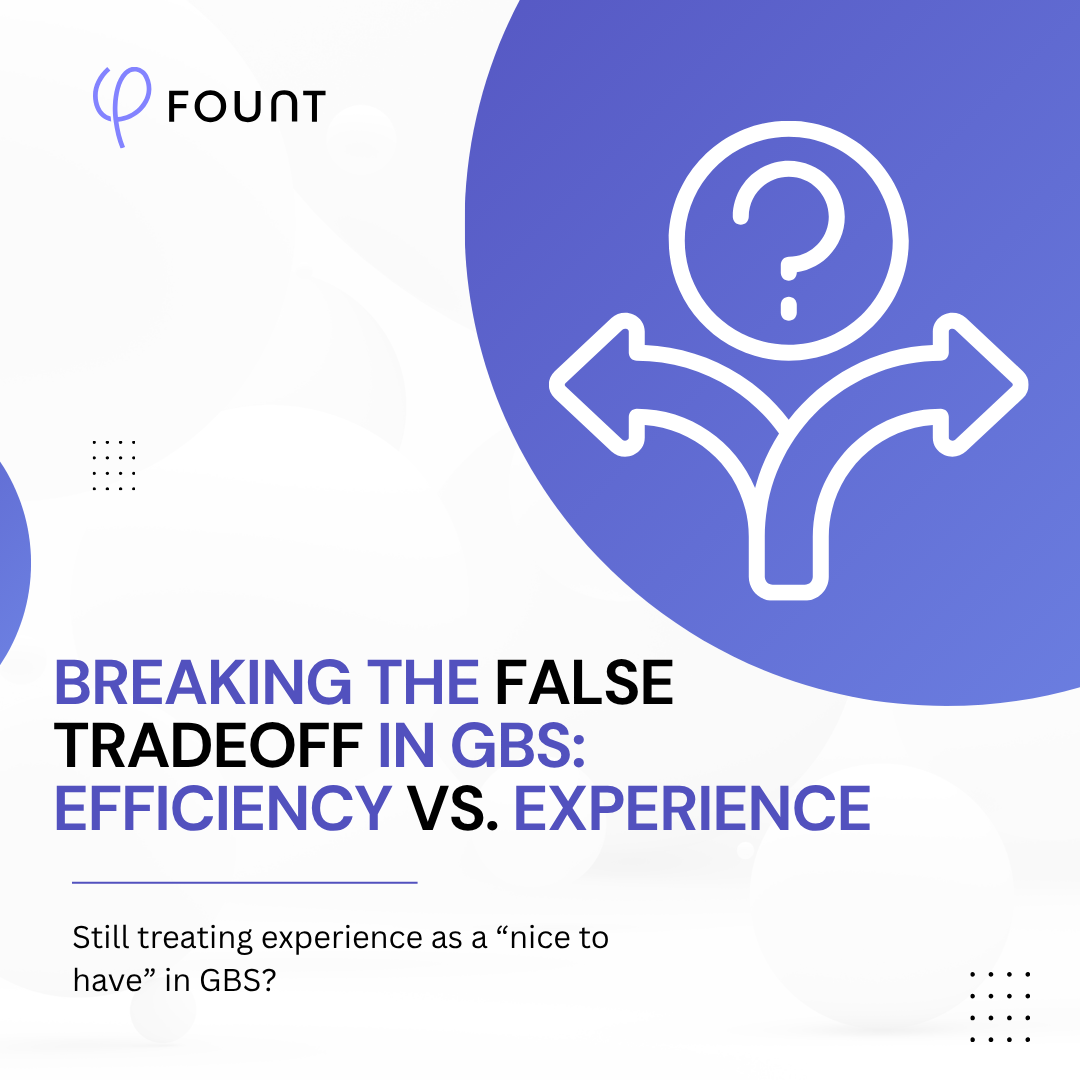
Breaking the False Tradeoff in GBS: Efficiency vs. Experience
With thanks to Stephanie Denino for sparking this line of thinking in her recent LinkedIn post
Traditionally, GBS has been optimized for one primary goal: reducing costs through efficiency. The KPIs have reflected this focus – cycle time, accuracy, cost per FTE.
But those metrics no longer tell the whole story. Expectations have changed. GBS leaders are now tasked with driving transformation, improving adoption, and delivering more value – with no additional resources. The current data isn’t enough.
The New GBS Imperative: Experience as a Strategic Lever
According to industry research:
- 35% of GBS leaders plan to prioritize internal customer experience within three years, recognizing that outdated efficiency-only models fail to address hidden costs like low adoption and rework (Deloitte).
- 44% now view customer centricity as a top strategic priority, according to SSON, with leaders emphasizing trust-building and user-centric design to drive long-term value.
This shift reflects a critical realization: efficiency and experience are interdependent.
“When employees struggle with fragmented tools or unclear processes, costs rise – even if SLAs are met.”
The Myth: Better Experience Means Higher Costs
There’s a common misconception that improving experience comes at the expense of efficiency. In reality, the opposite is often true:
“Efficiency isn’t the opposite of care. Often, it is the care.” – Stephanie Denino , Managing Director TI People
“The false choice between efficiency and experience is what holds so many GBS teams back! If it’s hard to use, it’s expensive to run” – Isabella Kosch , Transformation Consultant, ex-Head of GBS Service Management at Swarovski
Poor experience drives cost – through escalations, delays, abandonment, and low productivity. According to Gartner , poor employee experience contributes to higher turnover, more errors, and lower overall output.

What Poor Experience Looks Like
Imagine a new digital process aimed at reducing FTEs and increasing self-service. On paper, everything checks out – UAT passed, change management completed, SLAs met.
But employee frustration persists:
“I couldn’t find the answer.”
“I didn’t understand the steps.”
“I didn’t know where to go.”
As a result, support volume unintentionally rises, rework increases, and ROI stagnates. Why? Because the process was technically sound, but the experience was broken.
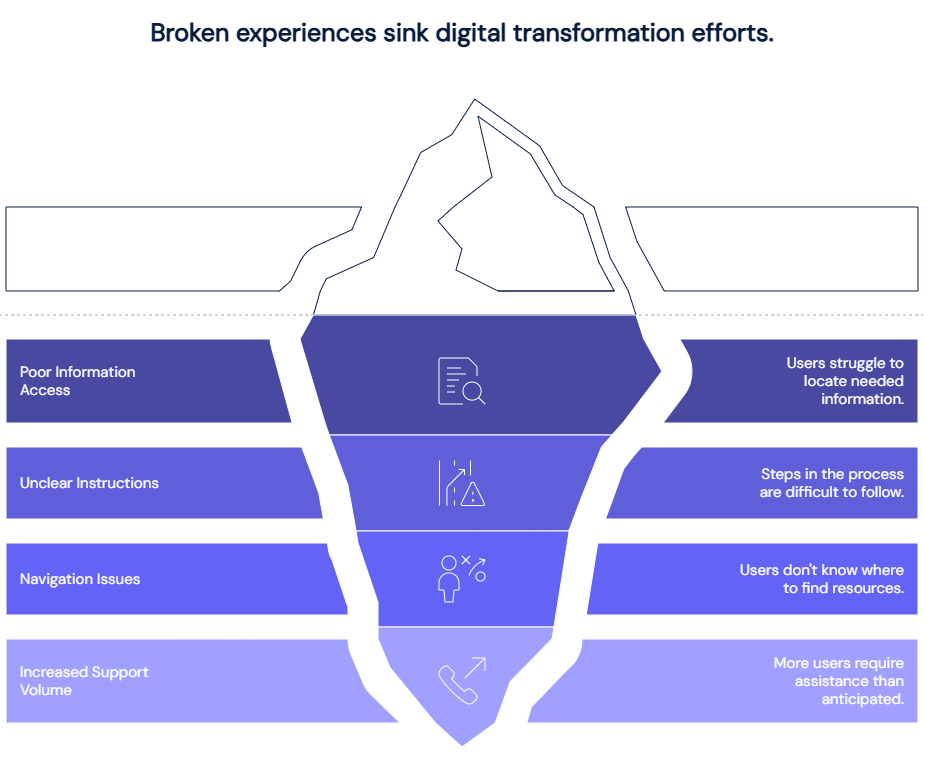
Why Traditional Metrics Fall Short
Most GBS teams rely on lagging indicators:
✔️ SLA breaches
✔️ Ticket volumes
✔️ Post-implementation NPS
✔️ System usage
These signals tell you what went wrong after the damage is done – but not why or where employees are getting stuck.
A met SLA for HR inquiry resolution doesn’t explain why 40% of employees abandon self-service portals. High system usage metrics might mask frustration with clunky interfaces that waste 2–3 hours per employee weekly.
And since IT, HR, and Operations often own different parts, the full experience remains uncoordinated.
The New Approach: Friction Data
Forward-thinking teams are now adopting friction data – a new measurement layer that reveals:
- Where work is breaking down
- How much time is being wasted
- Which tools or touchpoints cause frustration
- How to resolve issues proactively, before costs escalate
This structured data (like what FOUNT provides) allows GBS leaders to identify root causes of:
- Rework
- Abandonment
- Poor tool adoption
- Low productivity
It offers a shared view across silos- creating a roadmap for continuous improvement.
A Case in Point
At one global pharmaceutical company, friction data revealed a breakdown in the performance management process. The insights led to a redesign that:
- Saved over 30,000 hours
- Avoided $3.49M in costs
- Increased employee satisfaction by 22%
The Power of Reducing Friction
When friction is reduced:
- Employees need less support
- Tools are adopted more reliably
- Processes run closer to their intended design

You’re not overspending because you care too much about experience. You’re overspending because friction hampers adoption and inflates support costs.
To transform GBS from a cost center into a strategic value driver, you need more than dashboards and CSAT scores. You need visibility into how work actually feels – and where it’s breaking down – so you can actively improve it.
Sources:
- https://www.linkedin.com/posts/stephaniedenino_betterwork-ex-gbs-activity-7336382847592652802-A9IJ?utm_source=share&utm_medium=member_desktop&rcm=ACoAAAawMR8Bi7QFEzpwn_7YqdGYqwd5znLfG2o
- Chief Executive: Expanding GBS Adoption Through Increased Focus On Customer Experience
- SSON: Creating a Customer-Centric GBS: Focused Goals, Feedback & Vision
- Harvard Business School Online: Customer Experience Management Strategies for Brand Loyalty
- Psico-Smart: What are the hidden costs of neglecting employee experience management?
Register for the Upcoming Webinar, organized by SSON Beyond AI Hype: How to De-Risk Your GBS Transformation with Friction Data
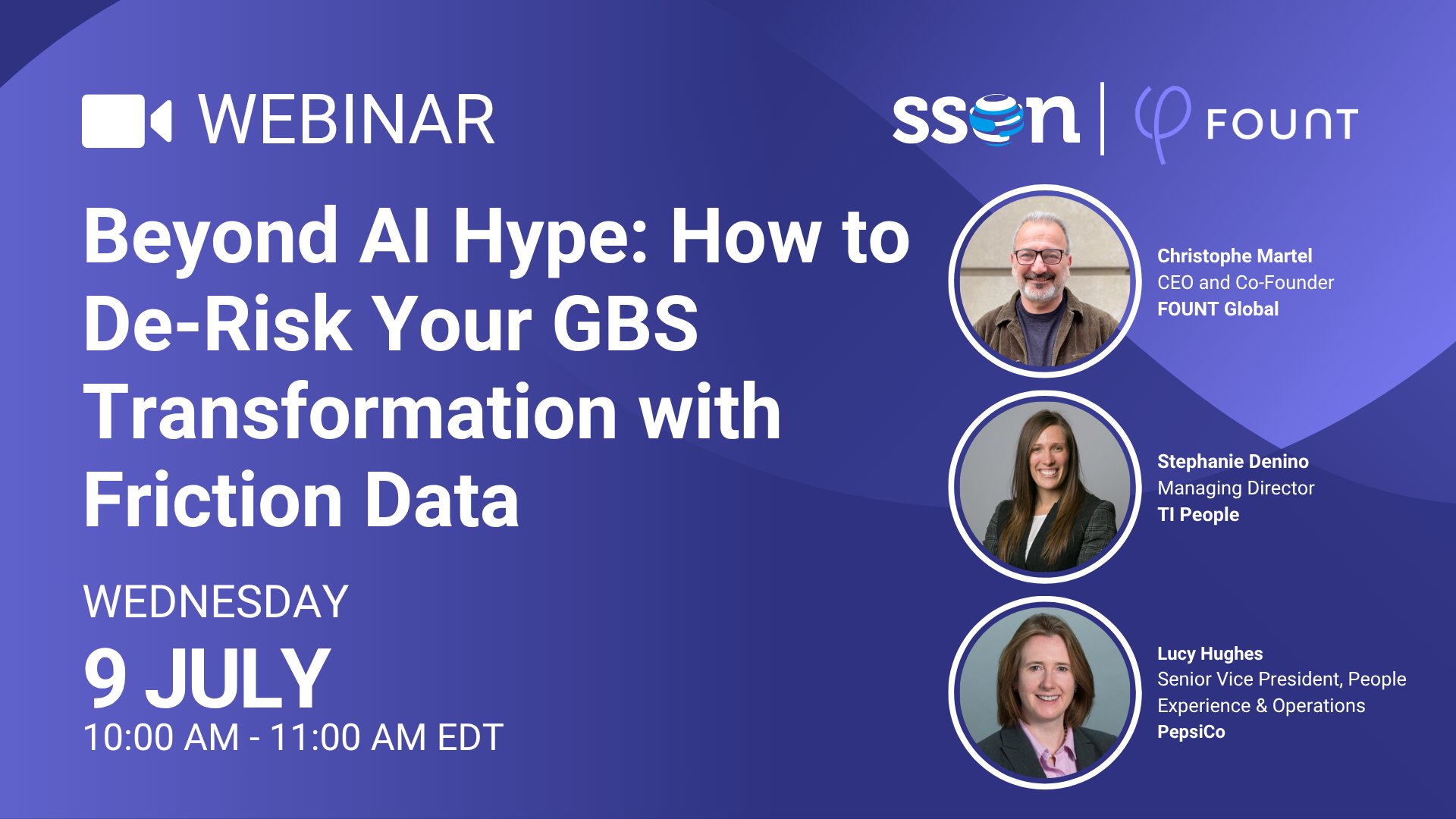
LIVE Webinar. Beyond AI Hype: How to De-Risk Your GBS Transformation with Friction Data
Today, ambitious GBS leaders are expanding the way they define transformative business value. Whilst their goals are growing, the data they use to de-risk their transformation hasn’t changed much.
This webinar will spotlight how GBS leaders are fixing a bigger problem: the way they measure work. Process Mining, SLAs, and ticketing systems only tell what happens after something goes wrong. They don’t show how to prevent problems before they start. In this session, you’ll hear real stories from leading GBS teams using a new kind of data – called friction data – to find and fix what slows workers down and leads them to reject new digital and AI-powered GBS tools.
Listen to industry experts from FOUNT Global, TI People, and PepsiCo as they discuss:
- Why Friction Data is the leading indicator of AI adoption and the gateway to de-risk digital GBS transformation.
- Understanding the methodology and framework to proactively measure friction in the day-to-day work.
- Learning the power of a unified data model to deliver superior cross-silo experiences to GBS customers.

3 Signs Your GBS Is Creating Friction Instead of Flow (And How to Fix It)
Guest Post by Isabella Kosch, freelance business consultant, ex-Head of GBS Service Management at SWAROVSKI, regular contributor to SSON.
Not all friction makes noise. Some of it hides in plain sight, camouflaged as efficiency.
After two decades in transformation, I’ve learned this: you can meet every target and still frustrate the people you’re supposed to serve. If you’re not asking how it feels for the user, you’re not managing flow. You’re managing optics.
Your GBS might be on time, under budget, and hitting every SLA. But if people are confused, waiting, or bypassing your systems, it’s not working.
Here are three signs your GBS is silently slowing everyone down:
1. Your help portal is built for the GBS team. Not for the user.
The portal is technically complete. Every form has been uploaded. Every process has a defined SLA. The chatbot knows its lines.
But users still bounce. They give up and ask around. Or worse, they go back to email.
Why? Because it reflects how you think about services, not how users search, ask, or decide.
One client showed me their immaculate portal. But the data told another story: users were abandoning forms midway, returning to email, or phoning their old local contacts.
When knowledge bases are structured by GBS ownership instead of user intent, employees end up bouncing from link to link.
Want to fix it? Start mapping what users are actually trying to do. Not what you’re trying to offer.
Forget the service catalog. Focus on user missions. What are the top three things people need? Build around that.
A portal that makes sense to you isn’t the same as one that works for them.
2. You standardized everything and now no one trusts it
Standardization is good. Until it isn’t.
When local teams feel unseen, they create their own fixes. Shadow trackers. Parallel approvals. Unofficial escalation paths.
I’ve seen this movie. A global onboarding workflow looks fine on paper. But in one region, people still organize their own welcome meetings. In another, HR adds three extra layers of compliance. In a third, managers stop using the tool entirely.
The resistance isn’t loud. But it’s there. And it costs more than you think.
In trying to protect scalability, you lose relevance.
In trying to enforce structure, you erode trust.
If local teams feel like your processes don’t see them, they’ll resist. Not loudly, but subtly. Delays. Pushbacks. Shadow fixes.
Instead of defending your global blueprint, ask where flexibility would actually increase trust.
Standard doesn’t mean identical. It means stable enough to flex where it matters.
3. Your dashboard says green. But your users are red.
There’s always a dashboard. And it’s always green.
But here’s what you’re not tracking:
- How often users follow up because they’re unsure
- How much time they waste re-explaining their issue
- How many quietly avoid your systems for important tasks
This is what I call the “false green.” It’s what happens when KPIs tell one story, but lived experience tells another.
I’ve seen this play out in payroll, IT, procurement – you name it. The process works. But trust is broken. And once that happens, it doesn’t matter how fast or cheap you are.
If your GBS isn’t trusted, it won’t be used. And if it’s not used, it can’t deliver value.
You don’t need to throw away your dashboards. You need to supplement them with qualitative feedback and frontline diagnostics. Friction often hides in escalation loops, repeated follow-ups, or in the silent choice to “just fix it ourselves.” Friction often lives in the gaps between your swimlanes.
If you want flow, focus less on control and more on credibility.
Fix what’s quietly broken. Rethink what “standard” really means. And design for how people actually behave, not how your process chart says they should.
Because process doesn’t equal progress. And operations don’t equal experience.
Prioritize experience.
Is your GBS trusted – or tolerated?
.svg)
Don't miss our latest content
Subscribe to our monthly newsletter


De-risk and Accelerate
Enterprise Transformations
FOUNT identifies the friction in your processes and technologies that slows down employee performance and transformation.
.svg)
Sign Up for Newsletter
Sign Up for
Newsletter
Monthly news and updates
By submitting this form, you confirm that you agree to the storing and processing of your personal data by FOUNT Global as described in our
Privacy Note
.svg)